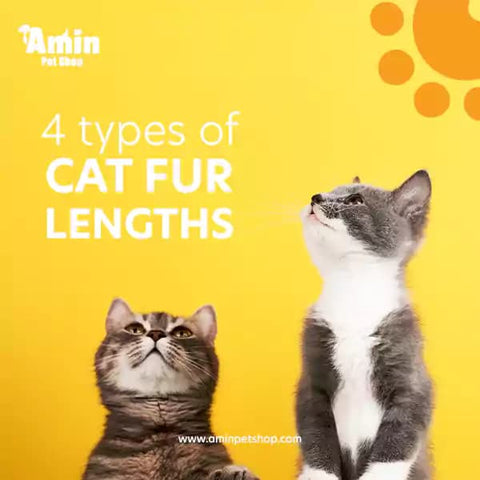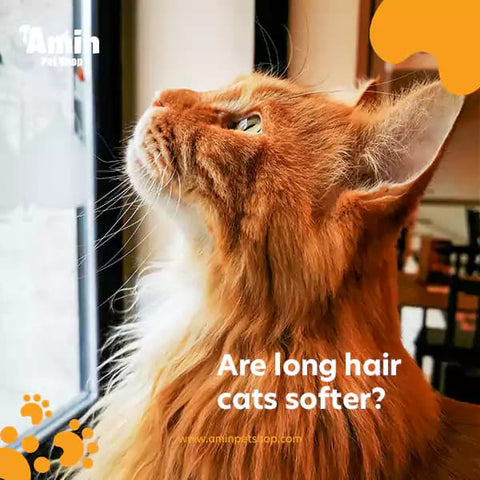Long-haired cats have fur flowing everywhere and may tangle. If your cat's coat is not long, it leans more towards medium hair.
4 types of cat fur lengths

Here is the bewildering question: Is my cat medium or long hair? With their captivating eyes and independent spirit, cats have captured our hearts for thousands of years. But besides their undeniable charm, another beautiful aspect is their anger. Just like human hairstyles, cat fur comes in a dazzling range of lengths, each with unique characteristics and requiring specific care. Let's delve into the world of cat fur, exploring the four main types: long hair, short hair, curly hair, and hair-free hair.
1. Long-haired Beauty: Consecutive Symphony of Softness
With the recognition of the answer to the baffling question, "Is my cat medium or long hair?" long-haired cats may enjoy undeniable elegance, and their fur flows into their bodies like a luxury cloak. This extended fur can reach anywhere from 1.5 to 5 inches, often with a soft texture. Breeds such as the majestic Maine Coon, the charming Norwegian forest cat, and the captivating Himalayas are critical examples of this category.
Living with a long-haired cat
You must provide complete care for your long-haired cat by following the following tips:
- Long-haired cats need regular brushing cleaning, ideally daily, to prevent glitter and keep a healthy coat. A metal comb and an elegant brush are essential for untangling and removing loose fur.
- Although all long-haired cats do not require frequent bathrooms, occasional declines can be helpful. Use a cute cat shampoo and conditioner specially designed for long-haired breeds.
-
Long-haired cats are more susceptible to hairballs due to their increased swallowing of fur. Consult your vet about diets or supplements to control hairballs.
Check out: Omni Guard Antiparasitic Shampoo
2. Shorthaired Allure: Sleek and Effortless Style
It is not yet forbidden to know the answer to a question. Is my cat medium or long hair? It is worth pointing out that shorthaired cats are the most common type, and their popularity stems from their easy-to-manage coats. Their fur is usually less than one inch long and flat on the body. This makes them a good choice for owners of busy or allergic cats. Popular abbreviations include playful Siamese, adaptable American Shorthair, and always curious Sphynx (yes, it's technically abbreviated, despite lacking fur!).
3. Curly-Haired Cuties: A Rare and Remarkable Breed
Curly-haired cats add a touch of the exotic to the feline world. Their coats, resembling miniature poodles, are caused by a recessive gene. These breeds are relatively new and rare, with the Rex family (Cornish Rex, Devon Rex, LaPerm) being the most well-known.
Don't miss: Pets Republic Foam Shampoo with Keratin
4. Hairless Wonders: The Allure of the Sphynx
For those seeking a genuinely unique feline companion, hairless cats, also known as Sphynx cats, are a fascinating option. These cats lack fur, except a fine down that feels warm suede. While initially surprising, the Sphynx's hairless body radiates heat, making them surprisingly cuddly companions.
Living with a Hairless Cat:
- Skin Care Regimen: Sphynx cats require regular skin cleaning with a gentle, pet-safe wipe to remove oils and keep their skin healthy.
- Sun Protection Essential: Sphynx cats are prone to sunburn like curly-haired cats. Sunscreen formulated for cats is a must, especially for outdoor adventures.
- Warm and Cozy: Hairless cats have a higher metabolic rate when maintaining their body temperature. Please provide them with plenty of warm sleeping areas and consider sweaters for colder climates.
Is my cat medium or long hair? Medium-haired kitten vs short hair
The critical difference between medium- and longhaired cats is their fur's overall length and uniformity. Here's a breakdown:
Longhaired Cat
- Fur is noticeably longer and flows throughout the body.
- Consistent length across their back, sides, and belly.
- Breeds like Persian, Maine Coon, and Ragdoll are classic examples.
Check out: Pet Brush: YB71985
Medium haired Cat
- Fur has a happy medium between short and long.
- Shorter fur on the back but noticeably longer on the:
- Neck (often forming a ruff)
- Belly
- Legs
- Tail (fuller and plumper than shorthaired cats)
- Breeds like Maine Coon (can have both long and medium hair variations), American Bobtail, and Turkish Angora can be medium-haired.
- Many mixed-breed cats also fall into this category.
Here's a tip: Look at your cat's tail. Shorthaired cats have thinner tails, while medium- and long-haired cats have fuller, plumier ones.
If you're still unsure, searching online for images of both coat lengths alongside your cat's breed (if you know it) can help you identify theirs.
How to decide which kind of cat hair is best for you
There isn't necessarily a "best" type of cat hair; it depends on your lifestyle and preferences! Here's a breakdown of the different types to help you decide:
- Short-haired cats are great for busy people who don't have much time for grooming. They shed less and require minimal brushing. Examples: Siamese, Abyssinian, American Shorthair.
- Long-haired cats are luxuriously soft and beautiful but require regular brushing to prevent matting. Examples: Persian, Maine Coon, Ragdoll.
- Hairless cats are perfect for allergy sufferers! Requires minimal grooming but may need occasional skin care. Examples: Sphynx, Donskoy, Korat.
- Curly-haired cats are rare and unique, with a poodle-like coat. Require regular brushing and may be higher maintenance. Examples: Devon Rex, Cornish Rex.
Can I tell how long my kitten's fur will grow?
It can be challenging to know how long your cat's fur will last as an adult, especially if you adopt it and don't know its breed. But some evidence can help you guess and answer many questions, including "Is my cat medium or long hair?"
Around 8 weeks old, kittens typically start showing signs of adult fur length. Here's what to look for:
- Tail: Fluffy tails hint at long or medium hair, while sleeker tails are more common in shorthaired cats.
- Ear tufts: If your kitten has little tufts of fur sticking out of their ears, they're more likely to have long fur.
- Paw fur: Longhaired kittens often have fur growing between their toes.
Shedding is another indicator. Kittens don't shed much until they're between 6 and 12 months old. That's when they lose their kitten fur and grow their adult coat. If your kitten sheds a lot around this time, it'll likely be a shorthaired cat.
Are long hair cats softer?

Cat lovers want to recognize the answer: Is my cat medium or long hair? There is a good chance that longhaired cats will be softer than short cats for several reasons, including:
- Guard hairs vs. down: Longhaired cats typically have two coat layers: a top layer of longer, coarser guard hairs and a denser undercoat of softer, finer fur called down. This down fur contributes to the overall feeling of softness.
- Breeds: Many popular longhaired breeds, like Persians and Himalayans, are known for their luxurious, silky fur due to the finer texture of their undercoat.
- Length: Longer fur can trap air and create a fluffier feeling, adding to the perception of softness.
However, it's not a guarantee. Here are some things to consider:
- Cat breed: Some shorthaired breeds, like Singapurahs, also have lovely fur and can feel quite soft.
- Cat care: Even longhaired cats can have rough fur if not properly groomed. Regular brushing helps distribute natural oils and keeps the coat free of mats, which can feel coarse.
All cats need proper care
Cats are wonderful companions but depend on us for their health and happiness. Providing proper care will not only keep your cat healthy but will also strengthen the bond between you. Here are some key things to remember:
Nutrition
Cats are obligate carnivores, meaning their diet must be rich in meat protein. Choose a high-quality cat food that meets their nutritional needs. Remember to provide plenty of fresh water, too!
Litter box
Cats are naturally clean animals and prefer a clean litter box. Scoop waste daily and completely change the litter regularly. Placement is essential, too - choose a quiet, easily accessible location.
Scratching post
Provide a scratching post to satisfy your cat's natural scratching instinct. This will help protect your furniture and carpets.
Veterinary care
Schedule regular checkups with your veterinarian. Kittens will need vaccinations, and all cats need parasite-prevention medication.
Playtime and enrichment
Cats are playful creatures. Dedicate daily time to interactive play with toys that stimulate their hunting instincts. Consider scratching posts with climbing features or environmental enrichment like cat trees.
Love and attention
Cats are social creatures who crave affection. Spend time petting, cuddling, and interacting with your cat.
Following these tips ensures your feline friend has a long, happy, and healthy life!
Learn more: Why is my cat hungry all the time?
Conclusion
Is my cat medium or long hair? Is your kitty's fur noticeably longer than short hair, especially around the neck and tail, but not flowing all over? Then your cat is likely medium hair. Does its fur seem long and luxurious all over, needing regular brushing? It might be long hair. If you're unsure, pictures of each fur type online can help!

